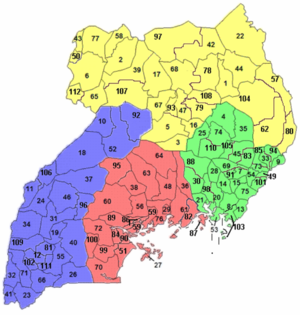Regions of Uganda


Central Western Eastern Northern
The regions of Uganda are known as Central, Western, Eastern, and Northern. These four regions are in turn divided into districts. There were 56 districts in 2002,[1] which expanded into 111 districts plus one city (Kampala) by 2010.[2]
The national government interacts directly with the districts, so regions do not have any definite role in administration. Under British rule before 1962, the regions were functional administrative units and were called provinces, headed by a Provincial Commissioner. The central region is the kingdom of Buganda, which then had a semi-autonomous government headed by the Kabaka (king). The equivalent of the Provincial Commissioner for Buganda was called the Resident.[3]
At Uganda's 2002 census, the Central region (It is coterminous with the Kingdom of Buganda, one of the ancient African monarchies that are constitutionally recognised in Uganda) contained 27 percent of the country's population, the Western region contained 26 percent, and Eastern region 25 percent, and the Northern region had 22 percent.[1]
The country's population density by region was 226 persons per square kilometre in the Eastern region, 176 per square kilometre in the Central region, 126 per square kilometre in the Western region, and 65 per square kilometre in the Northern region.[1]
In 2002, approximately 3 million people, or 12 percent of the country's population, lived in urban areas. The Central region had 54 percent of the urban population (mostly in the city of Kampala), the Northern region 17 percent, the Western region 14 percent, and the Eastern region 13 percent.[1]
| Region | Population (Census 1991) |
Population (Census 2002) |
Population (Census 2014) |
Area |
|---|---|---|---|---|
| Central | 4,843,594 | 6,575,425 | 9,529,227 | 61,403.2 km2 (23,707.9 sq mi) |
| Western | 4,547,687 | 6,298,075 | 8,874,862 | 55,276.6 km2 (21,342.4 sq mi) |
| Eastern | 4,128,469 | 6,204,915 | 9,042,422 | 39,478.8 km2 (15,242.8 sq mi) |
| Northern | 3,151,955 | 5,148,882 | 7,188,139 | 85,391.7 km2 (32,969.9 sq mi) |
See also
- List of regions of Uganda by Human Development Index
- Counties of Uganda
- Sub-counties of Uganda
- Uganda Local Governments Association
- ISO 3166-2:UG
References
- ^ a b c d "2002 Uganda Population and Housing Census" (PDF). Uganda Bureau of Statistics. Retrieved 18 June 2013.
- ^ "Status of Local Governments". Ministry of Local Government. Archived from the original on 18 September 2010.
- ^ Uganda Protectorate annual report, Government Printer, Entebbe, 1959
- ^ "Uganda: Administrative units". GeoHive. Archived from the original on 2013-05-11. Retrieved 18 June 2013.
- ^ "Uganda: Administrative Division". citypopulation.de. Retrieved 8 November 2016.
External links
